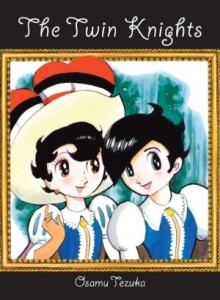By Osamu Tezuka. Released in Japan as “Futago no Kishi” by Kodansha, serialized in the magazine Nakayoshi. Released in North America by Vertical, Inc.
In this sequel to Princess Knight (well, the original Princess Knight, that is – the rewrite we saw here is still 5 years away), Osamu Tezuka shows us very clearly right from the start that this is a fairy tale, a stage production, a full-blown melodrama. No, even more, a mellerdrammer. This is a cartoon straight out of Mickey Mouse. It has talking animals, it has villains that are so paper-thin it’s amazing they don’t blow away, it has truly ridiculous plot contrivances, it’s has somewhat questionable gypsies (who are straight out of the European Comics Book Of Stereotypes), two sets of twins, multiple breaks of the fourth wall, including an appearance by Tezuka as himself, and an ending that does not so much end as simply stop.
I loved it. But it really does seem to have everything that folks find annoying in a Tezuka manga. More than anything, I think this is the style of manga Tezuka did that we haven’t really seen over here much. The quick, dashed-off adventure stories. Lots of animal characters. Glib protagonists with not much depth. This is a good chunk of his output, particularly at this point in his career. If you read Tezuka for titles such as Barbara or MW, I can see you finding this ridiculously cloying and silly. Which it is. But it’s also so much fun! I can’t tell you the number of times I was grinning like a maniac while reading this. Not just for the adventures of Daisy and Violetta – truth be told, Daisy is perhaps the weak point of the entire manga. No, for things like the evil Duchess simply having her henchmen back out a high window to their deaths for irritating her. Ridiculous, but fun.
As for the sexism or lack thereof, it’s not too bad given the era and country it was written in, and I think does slightly better than Princess Knight. Yes, Violetta is constantly yearning to be female and wear dresses, etc, and her relationship with Emerald is far more interesting than that of her with Prince White (if this plot were written today, Daisy would marry Prince White and pretend to be Violetta while she goes off with Emerald for more adventures). But there’s no denying that Violetta kicks ass throughout, and the last page does note “Well, she may dress up as a man and have adventures in the future.”
Even better, and my favorite scene in the entire book, is when she and her family are thrown into the tower by the evil Duke and Duchess. She and her mother are separated into one room, and Violetta starts to despair. Then her mother sees a couple of swords that were conveniently left on the wall (the duke and duchess are not exactly the smartest of villains… we’re talking Gargamel-level smarts here) and decides that Violetta needs to learn how to REALLY fence… and be taught by Princess Knight. Here we see that, despite choosing to be Queen and settle down to raise a family, Sapphire has never truly abandoned her upbringing as a boy (and in fact, clearly must keep in shape with the rapier, given that she kicks her daughter’s ass). I loved this bit of family bonding.
There’s a lot packed into the 240 pages we get here. I didn’t even mention the incredibly tragic deer, or the cartoon wolves (one of whom I swear is voiced by Billy Bletcher), or the truly weird art that we see in places (check out the duke on page 231… pure Tex Avery). It’s not deep… it is in fact the very opposite of deep. But it’s fun, and lively, and would make a great fairy tale for children. Which, of course, is what it was meant to be back in 1958. A great addition to the North American Tezuka canon.



